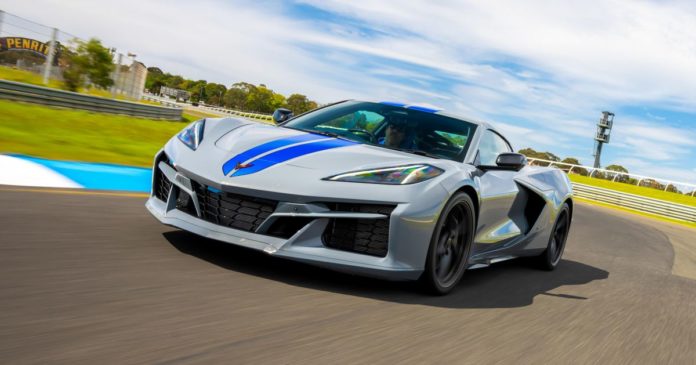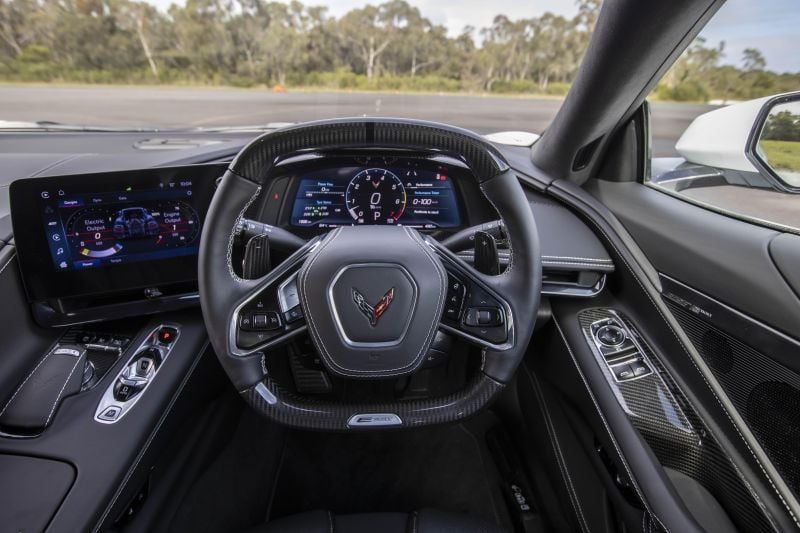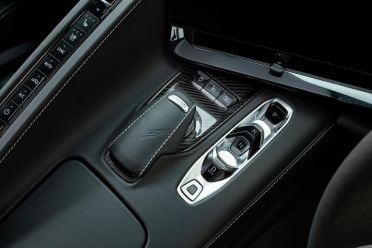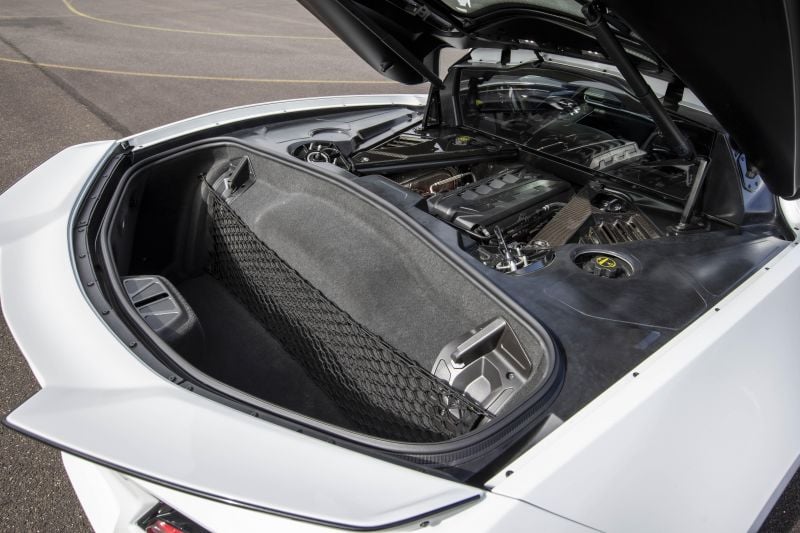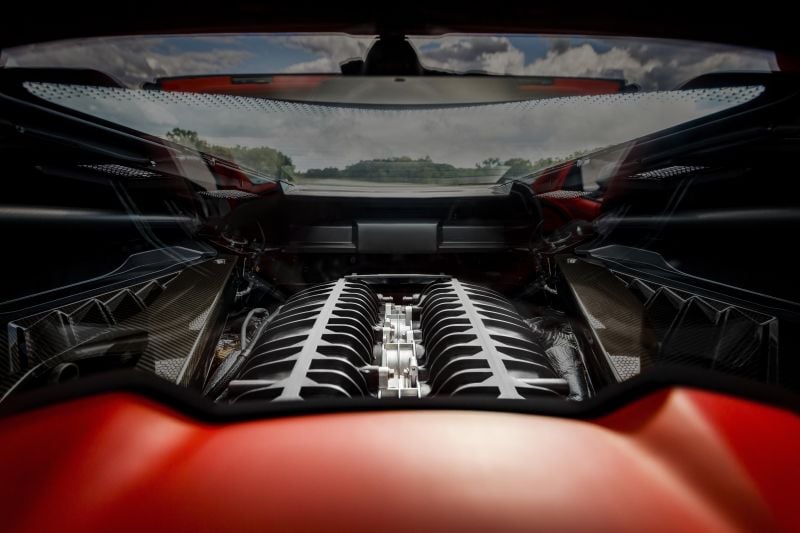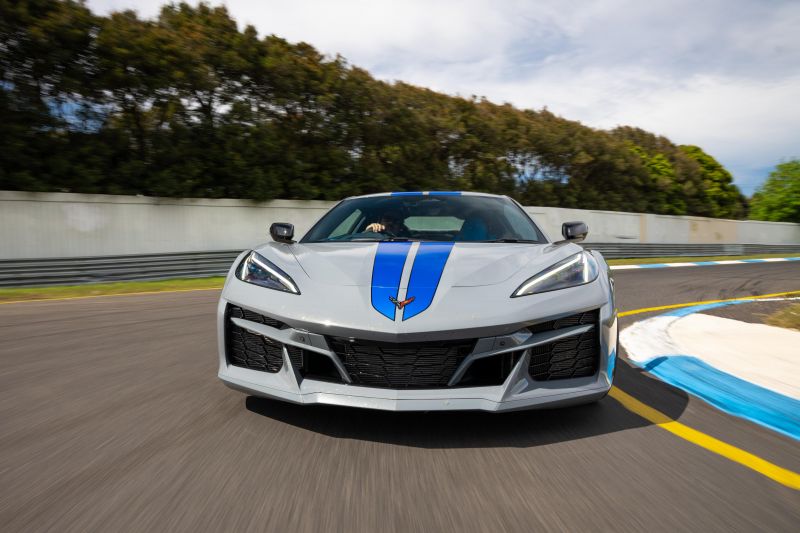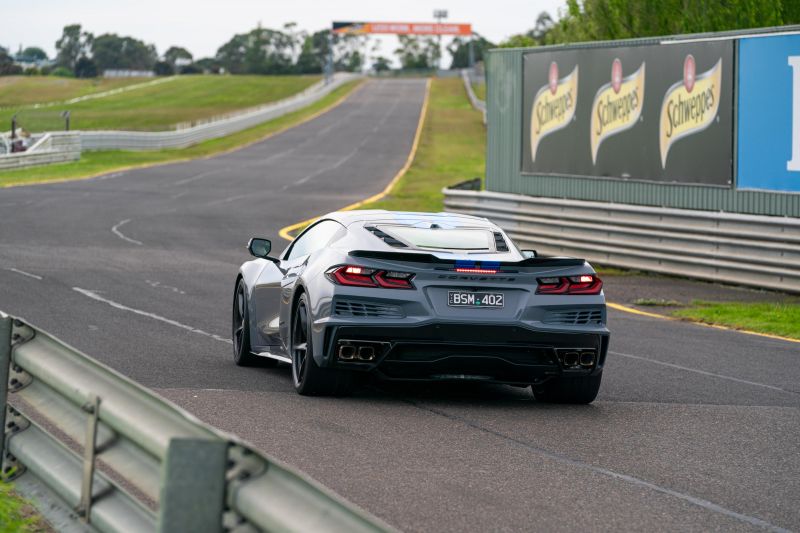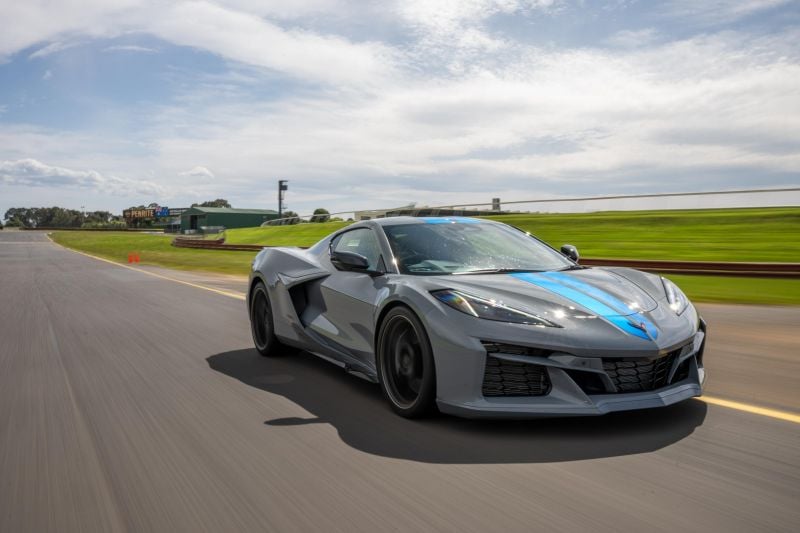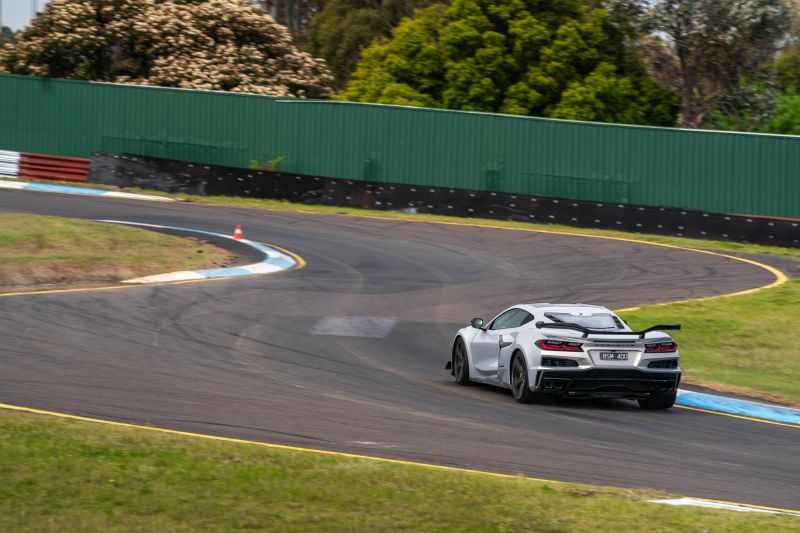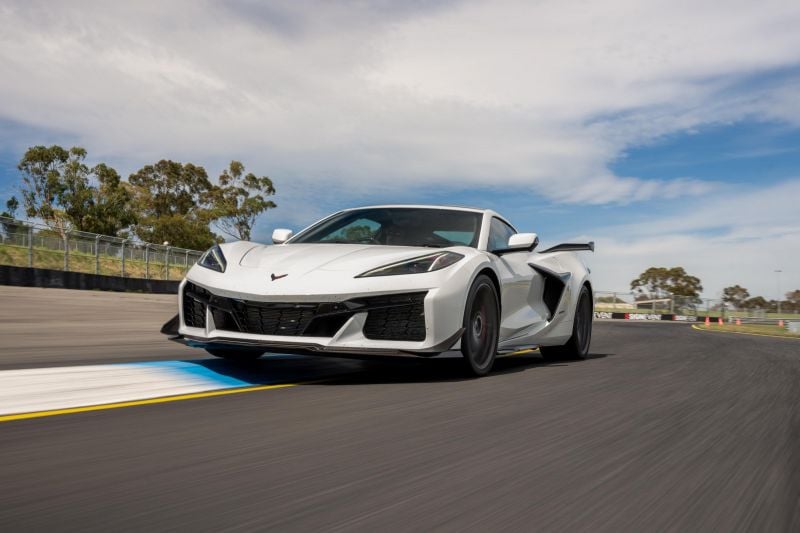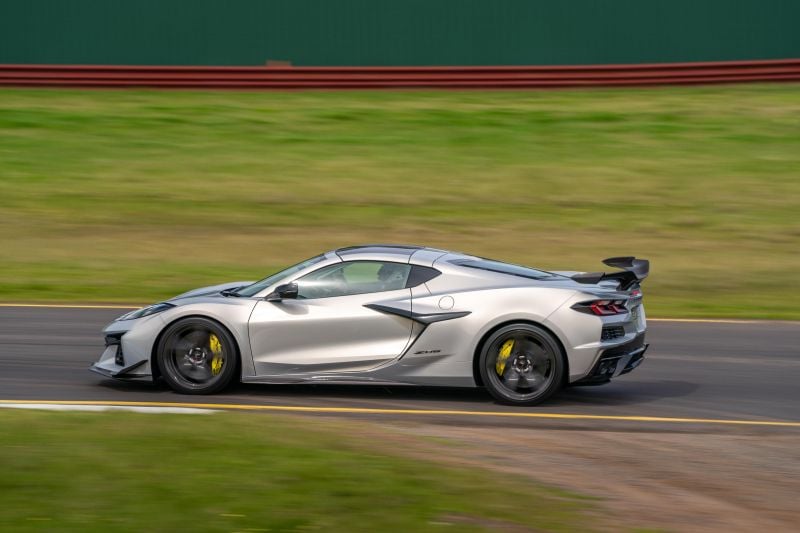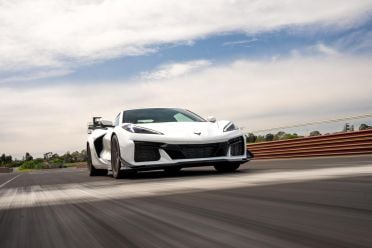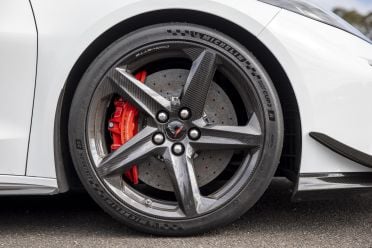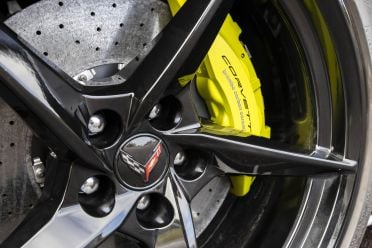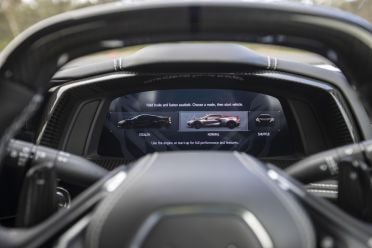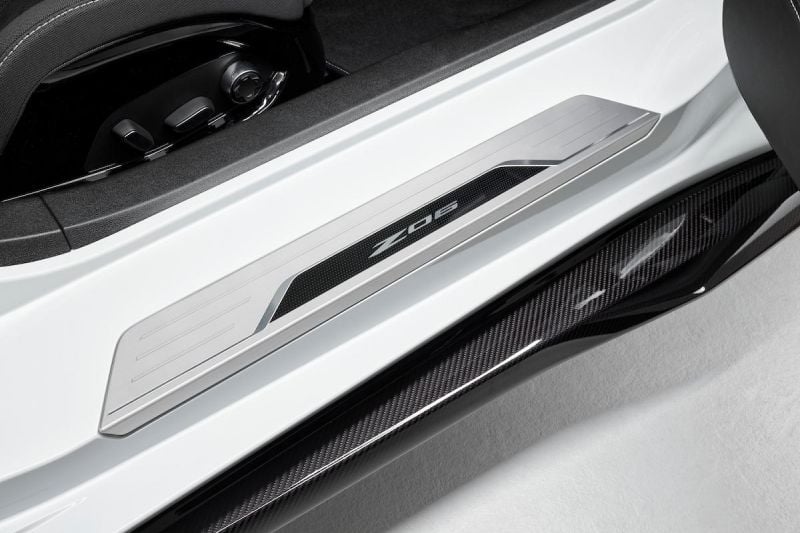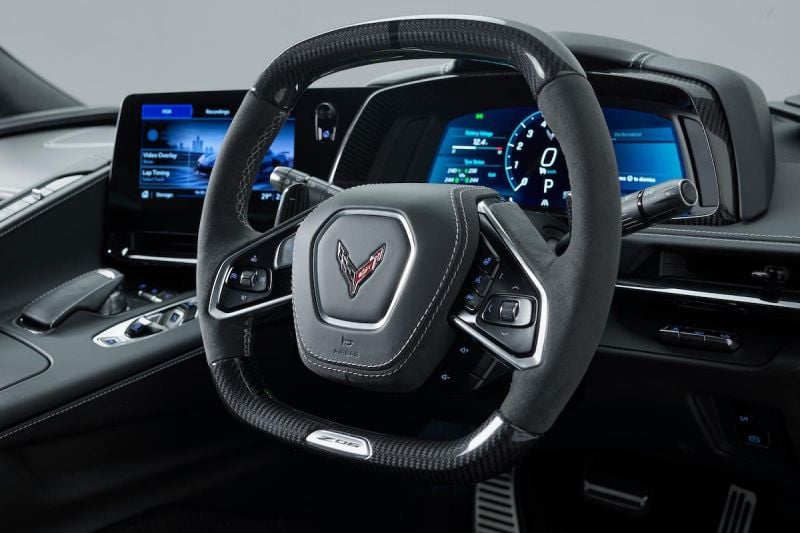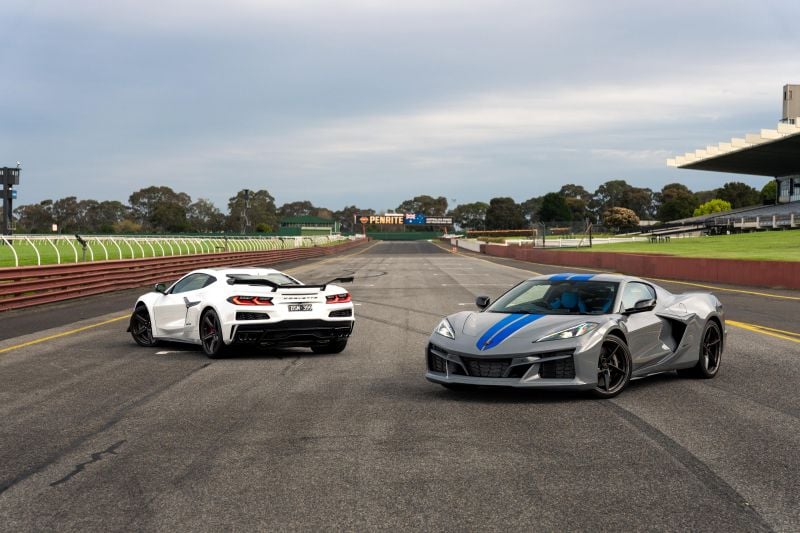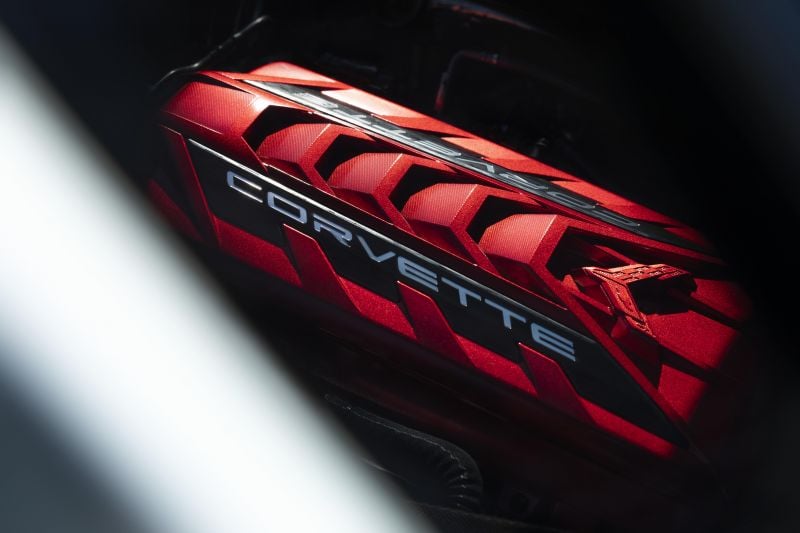The supercar segment is arguably the hardest hit by the electrification movement. How do you retain the appeal of blaring, rev-happy performance halos if you give them a soulless heart transplant?
There are few nameplates this applies to more so than the Chevrolet Corvette. For 70 years America’s original entry into the two-seater sports car market has been associated with big-block engines and bellowing exhaust notes.
But that’s not to say Chevrolet hasn’t overhauled the formula before. Despite mid-engined concepts being released numerous times over the decades, the Corvette has always been a front-engined super sports car – until the C8.
General Motors moved the Corvette’s beating V8 heart from front to rear for the first time with the eighth-generation ‘Vette, which saw it shift to being something of a super sports muscle car, or a “true luxury sports car alternative to Porsche, Ferrari and Lamborghini” – as company representatives describe it.
In perhaps an even greater departure from tradition, the C8 Corvette family is the first ever to be factory produced in right-hand drive, opening up official availability to markets like Australia and Japan for the first time.
If the ‘standard’ Corvette Stingray doesn’t have enough sting – mind you, it’s claimed to accelerate from 0-100km/h in just 2.9 seconds – the company will also sell you the motorsport-inspired Z06, and now you also have the choice of the first electrified ‘Vette in the hybridised and all-wheel drive E-Ray.
Pitched as the ‘Touring Supercar’, the E-Ray slots in between the Stingray and the Z06 in terms of pricing and aggression, offering additional performance over the base car as well as all-paw traction that is unique in the lineup.
Meanwhile, the Z06 is Chevrolet’s take on the 911 GT3 formula that sees it swap out the LT2 6.2-litre V8 for the newer LT6 5.5-litre flat-pane crank V8 which, with 475kW of power and 595Nm of torque is the most powerful naturally aspirated V8 to feature in any production car, ever.
To see if GM’s claims have any weight, we joined General Motors Specialty Vehicles (GMSV) for a track drive of the new E-Ray and Z06 at Sandown in south-east Melbourne.
How does the Chevrolet Corvette compare?
View a detailed breakdown of the Chevrolet Corvette against similarly sized vehicles.

Chevrolet
Corvette
How much does the Chevrolet Corvette cost?
The Corvette E-Ray is a cool $100,000 dearer than the base Corvette Stingray 2LT Coupe.
| Model | Price before on-road costs |
|---|---|
| 2025 Chevrolet Corvette Stingray 2LT Coupe | $175,000 |
| 2025 Chevrolet Corvette Stingray 3LT Coupe | $190,000 |
| 2025 Chevrolet Corvette Stingray 2LT Convertible | $190,000 |
| 2025 Chevrolet Corvette Stingray 3LT Convertible | $205,000 |
| 2025 Chevrolet Corvette E-Ray Coupe | $275,000 |
| 2025 Chevrolet Corvette Z06 Coupe | $336,000 |
To see how the Corvette lines up against the competition, check out our comparison tool.
MORE: 2025 Chevrolet Corvette price and specs
What is the Chevrolet Corvette like on the inside?
If you’re still of the mindset that the Americans can’t put together a nice interior, you need to look at the C8 ‘Vette.
-

E-Ray
Draped in swathes of high-end leather, with flashes of carbon-fibre accents and attractive topstitching, the Corvette feels suitably high-end and much more competitive with European exotics despite asking for far less coin.
The E-Ray picks up a carbon fibre-accented leather steering wheel as standard equipment, and the eight-way power-adjustable GT2 seat design from the higher-grade 3LT Stingray carries over. If you want something racier, you can specify Competition seats too.
As you can see from the images, the Corvette’s interior features a wraparound design that angles all of the key functions and switchgear towards the driver, headlined by high-definition instrument and infotainment displays, as well as a strip of buttons down the cockpit divider that are quite fetching – if a little confusing ergonomically.
GM offers a comprehensive level of customisation to the interior of the Corvette, with a range of upholsteries, trims and seatbelt colour options available upon request.
-
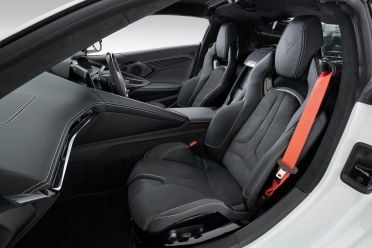
Z06 -
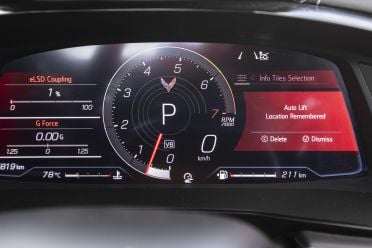
It’s a fairly compact cabin given the big V8 engine is sitting behind you regardless of variant, though at 6’1″ I didn’t have any issues with sitting in the E-Ray and Z06 coupes with a racing helmet on. It’s a shame Australia isn’t offered drop-top variations of either, despite them being available in the States.
The chunky bucket seats are very comfortable and offer plenty of bolstering, though I wonder if they cater to those with greater lateral proportions than I. Given we only drove the E-Ray and Z06 on track, I can vouch for their comfort and body-hugging capability when driving at the limit – though I would be interested to trial their touring comfort.
Ahead of the driver is a 12-inch digital instrument cluster with an array of viewing options and widgets to cycle through, to help put your preferred information in front of you. It’s augmented by a projector-type head-up display, both of which can show rev counters and shift lights to make sure you’re hitting the next cog at the right time.
It all feels very focused and pretty high-end, befitting of the $200,000-$300,000 price tags and arguably more impressive when you consider rivals from brands like Ferrari and Lamborghini will easily cost you twice the cash.
Being a mid-engined supercar doesn’t mean Chevrolet hasn’t thought about everyday practicality either. After all, this is being marketed as a daily-usable vehicle.
There are a number of storage cubbies and solutions to help stow your things while you enjoy the ‘Vette’s incredible performance, including a phone cradle that doubles as a wireless charger, a pair of lidded cubbies as well as small door compartments for smaller items.
It’s also worth noting the switchgear on the centre console, the trigger-like buttons used for the drive selector and the rotary dial alongside it used to toggle different drive and traction modes. I personally needed a couple of goes to get my head around it all, but once I got the hang of it, it all made sense and has a dash of cool factor too.
Boot space? There’s a claimed 357 litres across the front and rear boots.
| Dimensions | Corvette Stingray | Corvette E-Ray | Corvette Z06 |
|---|---|---|---|
| Length | 4634mm | 4688mm | 4734mm |
| Width | 1934mm | 2025mm | 2025mm |
| Height | 1234mm | 1234mm | 1234mm |
| Wheelbase | 2722mm | 2722mm | 2722mm |
| Dry weight | 1601kg – Coupe 1638kg – Convertible |
1781kg | 1661kg |
To see how the Corvette lines up against the competition, check out our comparison tool.
What’s under the bonnet?
The Corvette offers two core V8 petrol engines depending on the variant, with the E-Ray adding a hybrid system to the Stingray’s 6.2-litre unit.
| Specifications | Corvette Stingray | Corvette E-Ray | Corvette Z06 |
|---|---|---|---|
| Engine | 6.2-litre V8 | 6.2-litre V8 hybrid | 5.5-litre V8 |
| Engine power | 369kW | 369kW | 475kW |
| Engine torque | 637Nm | 637Nm | 595Nm |
| Electric motor power | – | 120kW | – |
| Electric motor torque | – | 165Nm | – |
| Combined power | – | 488kW | – |
| Combined torque | – | 806Nm | – |
| 0-100km/h – claimed | 2.9 seconds | 2.5 seconds | N/A |
| Transmission | 8-speed dual-clutch auto | 8-speed dual-clutch auto – engine Single-speed – e-motor |
8-speed dual-clutch automatic |
| Drive type | Rear-wheel drive | All-wheel drive | Rear-wheel drive |
| Battery capacity | – | 1.9kWh li-ion | – |
| Fuel consumption – US EPA | 12.4L/100km | 12.4L/100km | 15.7L/100km |
| Fuel tank capacity | 70 litres | 70 litres | 70 litres |
To see how the Corvette lines up against the competition, check out our comparison tool.
How does the Chevrolet Corvette drive?
Now, the fun part!
We got a series of three or four laps in both the E-Ray and the Z06, meaning we didn’t get an extended period of time to really thrash them and test their limits. What I can give you, though, are initial thoughts on the differences.
First up was the E-Ray, and boy does it have some presence compared to the Stingray – even without any added aero bits like what’s available on the Z06 track special. Like the aforementioned Z06, the E-Ray scores the wide body kit, adding 9.4cm to the width at the rear.
It certainly adds some street cred and helps the non-spoilered ‘Vette look like a bona fide supercar. The classic light coloured body with blue racing stripes brought visions of Le Mans racers and homologation specials, and the polished wheels on one of the test cars gave it a very clean and measured look.
But, while it’s ‘very demure’ and ‘very mindful’ in its understated appearance, the E-Ray is borderline unhinged in the way it delivers performance, backed by the added confidence of offering drive from the front axle.
There’s layers to it, too. You can start the E-Ray in Stealth Mode, which offers 4-6km of electric driving range from the small 1.9kWh lithium-ion battery. You can travel at speeds of up to 72km/h, allowing you to slip away from home on early mornings without waking up your family or the neighbours.
Once you’re clear, you get the monstrous bellow of the 6.2-litre V8, which fires to life and quickly brings system outputs to a whopping 488kW and 806Nm at their respective peaks. You don’t have to feather the throttle to use it either, thanks to the eAWD system that sends the electric motor’s torque to the front and the V8’s to the rear.
At full noise using launch control, the Corvette E-Ray has enough go from the moment you set off the line to make you feel like your face is melting off. Even better, it has a fulsome V8 soundtrack blaring right behind you, with the added supercharger-like whine from the e-motor to make for a captivating experience – plus, it’s bloody fast.
Chevrolet claims a 2.5-second 0-100km/h sprint time and, using the vehicle’s on-board timing gear for a standing start, we saw an indicated 2.4-second run. This is quite possibly the quickest-accelerating car I have ever driven.
Standard carbon-ceramic brakes on the E-Ray ensure there’s plenty of stopping power to slow you down almost as quickly, though in my experience it felt like it lacked bite in the initial pedal travel. Add more force, though, and you’re very quickly wiping off speed as you come into a sharp left-hander like Sandown’s first apex.
In its track setting the E-Ray keeps the battery juiced using the V8 engine, so the front axle is always primed for maximum performance, and the way the electrified ‘Vette instantly pulls from whatever speed and whatever gear is relentless. There’s so much pace you’ll see 200km/h approaching on a long straight in no time.
It’s a similar story with the handling. The E-Ray feels grippy and secure even if you apply throttle a little early out of a corner. Unlike the Z06 – which we’ll get to in a bit – the E-Ray feels less like it wants to scare you and more like it will rocket you to wherever the steering wheel is pointed.
It’s a tad softer and less visceral than the Z06 on track, but for some that may be the preferred experience – especially if you plan on using your Corvette on the road more often than not.
After heading back to pit lane and jumping into the driver’s seat of a Z06 with optional Z07 Package – meaning carbon-fibre aero upgrades, stickier Michelin Pilot Sport Cup 2R tyres, and performance suspension with Magnetic Selective Ride Control – the whole experience on track is dialled up to 11.
From the moment you fire up that 5.5-litre flat-pane crank V8, the Z06 feels like a different beast. There’s a more high-pitched and smoother exhaust note that’s reminiscent of racing cars, while the free-revving character and shorter final drive ratio (5.56) for the eight-speed dual-clutch automatic makes this feel much more eager for track work.
Once we head out of pit lane I immediately noticed the more focussed ride and the less generous sound deadening, all of which adds up to an immersive and pure track experience. Genuinely, I felt like I was driving a race car.
Everything feels a touch more dialled in and focused compared to other Corvette variants, and it’s insanely quick like the E-Ray but in a different kind of way.
The Z06 wants you to drive it hard and fast, and almost feels like it’s tugging at the figurative leash, begging you to give it 10-10ths for every moment you’re on circuit. Remembering it’s sending 475kW and 595Nm to the rear axle only, it’s a little intimidating at first.
Weighing 120kg less than the E-Ray, the Z06 feels lighter on its feet and sharper in how it responds and changes direction. The E-Ray might outgun it on the straights, but the Z06 will leave its sibling behind in the bends.
You definitely feel like you have to build up pace in the Z06 to get a feel for it before you really go all out. I didn’t get on the gas too early in my short drive to make it kick out or misbehave, but it definitely felt like it’d bite back at me if I wasn’t careful.
It also revs out so quickly that once or twice I hit the limiter in manual mode before shifting, and at 200 clicks on the main straight the harder suspension definitely amplified every imperfection of Sandown’s main strip. Further, when hitting the anchors at the end of said straight, the Z06 had a habit of pulling to the left, meaning I had to really focus on my line into turn one.
Of the two, I preferred the balance of the E-Ray on track, but I can understand how keen track day drivers that want the most visceral experience and the most honed circuit tool will be drawn to the Z06.
That said, the Z06s we tested were heavily optioned, which is worth considering if you’re conscious of the price skyrocketing. It already costs $60,000 more than the base price of the E-Ray, with the as-tested options adding up to tens of thousands of dollars – clearly, Porsche was the inspiration behind the options structure.
The Z07 Package with Magnetic Selective Ride Control adds $6720, while the visible carbon rear wing adds a further $13,000. Want carbon-ceramic brakes? Unlike the E-Ray they cost $16,990 extra.
You can even option carbon-fibre wheels made by Aussie firm Carbon Revolution. They’re very sexy, but if you want them on your ‘Vette Z06 they’ll cost you a whopping $23,990. Wow.
Still, what a car.
Hopefully, we’ll get a chance to get a more in-depth drive of the Corvette E-Ray and Z06 soon, including some time on the road as well as the track.
What do you get?
Corvette Stingray 2LT highlights:
- Front lift suspension system
- Keyless entry and start
- Heated and power folding mirrors
- Soft-close engine hatch cover
- Soft-close front boot lid (NEW)
- Engine appearance package
- 19-inch front, 20-inch rear 5-spoke wheels – Bright Silver
- Michelin Pilot Sport 4S tyres – Z51 Performance Package
- GT2 bucket seats in Nappa leather with perforated inserts
- 8-way powered seats with memory
- incl. powered bolsters and lumbar adjustment
- Heated and ventilated seats
- Suede microfibre-wrapped A-pillars, headliner and rear seat covering
- Leather-wrapped and heated steering wheel with power adjust
- Leather-wrapped instrument panel
- Leather door panels
- Luggage nets front & rear
- 12-inch configurable driver’s instrument cluster
- 8.0-inch infotainment touchscreen
- Satellite Navigation
- Apple CarPlay and Android Auto (wireless)
- Head-up display
- Performance data recorder
- Wireless phone charging
- Bose 14-speaker sound system
- Dual-zone climate control
Corvette Stingray 3LT adds:
- GT2 seat design
- Leather-wrapped instrument panel
- Suede microfibre-wrapped upper interior
Corvette E-Ray adds:
- 20-inch front, 21-inch rear alloy wheels
- Wide body (+9.4cm)
- ZER Performance Package
- ZER Performance Suspension
- Magnetic Selective Ride Control
- Michelin Pilot Sport 4S ZP Performance tyres
- Spoiler wicker
- Brembo carbon-ceramic brakes
- Performance exhaust system
- Stealth Mode
- Performance app
- Ground effects
Corvette Z06 adds (over Stingray):
- Carbon-fibre steering wheel trim
- Suede microfibre door trim
- Revised final drive ratio (5.56)
- Magnetic Ride Control 4.0
- 6-piston front brakes
- Unique rear spoiler with adjustable wickerbills
Is the Chevrolet Corvette safe?
The Chevrolet Corvette has not been independently crash tested in the US or Australia – and is therefore unrated.
Standard safety equipment includes:
- 4 airbags
- Autonomous emergency braking (AEB)
- incl. pedestrian detection
- Auto high beam
- Blind-spot monitoring
- Cruise control
- Lane departure warning
- Lane keep assist
- Rear park assist
- Front and rear cameras
- Rear cross-traffic alert
How much does the Chevrolet Corvette cost to run?
The Chevrolet Corvette range is covered by a three-year, 100,000km warranty – whichever comes first.
Australian-delivered Corvettes also come with three years of what GMSV calls Roadside Ultra Assistance. Service intervals and costs have not been announced.
To see how the Corvette lines up against the competition, check out our comparison tool.
CarExpert’s take on the Chevrolet Corvette
I might just be in love.
In the era of electrification and downsizing, the first mid-engined and first factory right-hand drive Corvette is radically new in many respects, but retains its core attributes while honing an iconic formula for the modern age. And, it’s a relative bargain compared to its European counterparts.
And the E-Ray and Z06 bolster an already exciting package in very different ways. While the E-Ray adds straight-line pace, everyday usability and eAWD traction over the Stingray, the Z06 offers endless customisation and an insatiable appetite to slice through every bend in the road ahead.
Our time with both versions was brief, but it’s clear Chevrolet and GM aren’t kidding when they say they’re gunning for the big boys in the supercar space.
If it was my money on the line, I’d be drawn to the E-Ray. It’s quicker in a straight line and offers a wider breadth of talent better suited to daily use, and the widebody proportions make it look more substantial than the Stingray. Plus, you’ll save $60,000 off the base price of the bonkers (but loveable) Z06.
Interested in buying a Chevrolet Corvette? Get in touch with one of CarExpert’s trusted dealers here
Click the images for the full gallery
MORE: Everything Chevrolet Corvette

